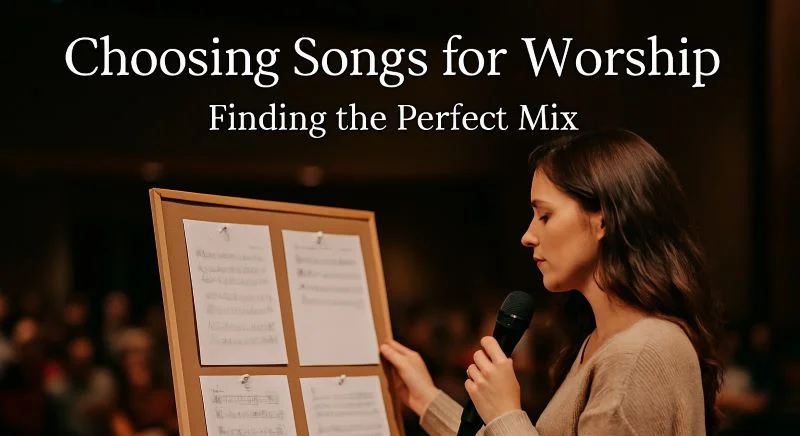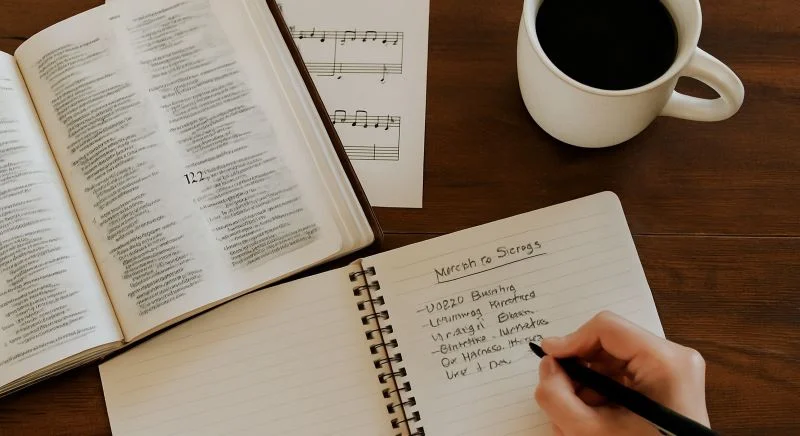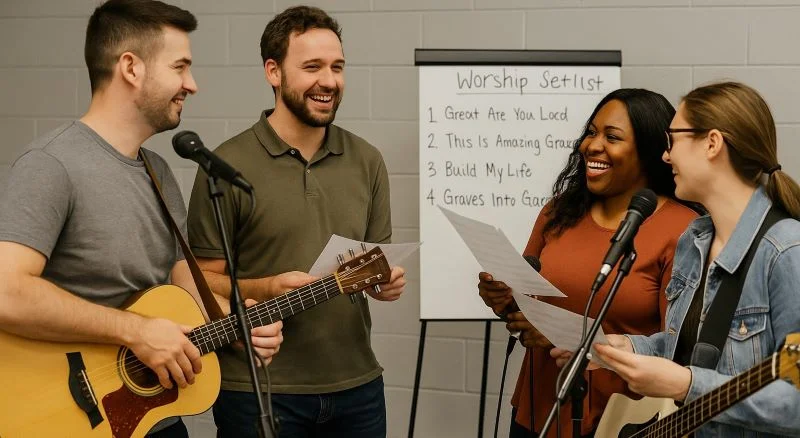
I’ll never forget one Sunday morning. The worship leader was having a great time, singing her heart out to the Lord. The team was on point, the instruments were tight, and the transitions were smooth. But as I looked around at the congregation, something felt off.
Some were fiddling with their phones. A mom was busy calming down her toddler. A few stood still, staring blankly into the distance. There was a huge disconnect. The worship team was singing to us, not with us.
Leading worship isn’t just about singing passionately. It’s about choosing the right songs—songs that invite people in, help them engage, and make space for God to move.
Worship is more than music—it’s a spiritual encounter. And the songs we choose set the tone for that encounter. If you’ve ever struggled to find the perfect mix, this guide is for you.
1️⃣ Start With Prayer and God’s Direction
Before anything else, pray. Ask God to guide you as you build your setlist. What does He want to say to His people this week? What burdens are they carrying? What does He want them to declare in worship?

Choosing songs for worship is a spiritual task. The Holy Spirit knows what your congregation needs even before they arrive.
2️⃣ Align Songs With the Sermon or Weekly Theme
Coordinate with your pastor or teaching team. Ask about the passage or topic for the week. Is it about faith in trials? God’s mercy? Spiritual warfare?
Matching songs with the sermon deepens the impact of the entire service. It builds a sense of flow, reinforcing the message from the opening song to the final prayer.
💡 Pro Tip: Keep a running list of songs sorted by theme to make planning easier.
3️⃣ Choose Songs With Solid Theology
Lyrics matter. Avoid songs with vague or shallow language. Ask yourself:
- Does this song align with Scripture?
- Is it God-centered or overly self-focused?
- Does it reflect sound doctrine?
We’re not just singing catchy tunes—we’re leading people to declare truths about who God is.
Checklist for evaluating lyrics:
- Is Jesus the focus?
- Are the lyrics biblically accurate?
- Could the song be sung in a different religion? (If yes, reconsider.)
4️⃣ Consider Congregational Singability
It doesn’t matter how great a song is if no one can sing it.
Choose songs with:
- A comfortable vocal range (usually an octave)
- Predictable melodies
- Repetitive, memorable phrases
A good rule of thumb: if your average non-musician can hum the chorus after one listen, it’s probably singable.
Try the “whistle test”: If you can whistle it easily, your congregation can likely sing it.
5️⃣ Create a Balanced Setlist
Think of your worship set as a journey. You want to lead people from the outer courts to the holy of holies.
Include a mix of:
- Upbeat praise songs to start with energy
- Reflective or prayerful songs to lead people inward
- Declarations of faith or response songs to close strong
Also, mix:
- New songs with familiar ones
- Different tempos and time signatures
- Songs in various keys for vocal comfort
Avoid too many slow songs in a row—you risk losing engagement.
6️⃣ Choose Songs That Fit Your Team

Be honest about your worship team’s current ability.
Don’t pick songs that are too vocally demanding or musically complex if your team isn’t ready. Simpler songs done well are more powerful than difficult songs done poorly.
Build up your team, but don’t burn them out.
7️⃣ Plan Transitions and Flow
Great worship isn’t just song after song—it’s a seamless experience.
Plan how you’ll move between songs:
- Use Scripture readings
- Share a short exhortation
- Transition musically between keys
Smooth transitions reduce awkward pauses and help people stay connected.
Example: Going from “Great Are You Lord” in E to “What a Beautiful Name” in D? Plan a short instrumental bridge or modulation.
8️⃣ Introduce New Songs Gradually
People don’t connect with songs they don’t know. Limit new songs to one per service, and repeat them often in the following weeks.
Tips for teaching new songs:
- Introduce them during offering or post-sermon slots
- Explain why you’re introducing it
- Share Scripture that inspired it
Let the congregation learn at a natural pace.
9️⃣ Make Space for the Spirit
Leave room in your planning for spontaneous moments.
That might mean repeating a chorus, lingering on a bridge, or even pausing for silence. Trust the Holy Spirit to lead the worship, not just your setlist.
Be sensitive to what’s happening in the room.
🔟 Watch and Learn From Your Congregation
Pay attention to their response:
- Are they singing?
- Are they engaged?
- Do they seem confused or disconnected?
If a song consistently falls flat, set it aside. Your job is not to showcase great music; it’s to facilitate meaningful worship.
Use feedback and observation to refine your choices.
Key Takeaway

The best worship songs aren’t the trendiest or most emotional—they’re the ones that help your church connect with God. Choose songs that are biblically sound, singable, Spirit-led, and thoughtfully planned.
Worship is not a performance. It’s an invitation. Make every song count.
FAQs About Choosing Worship Songs
Q: How often should I introduce new worship songs?
A: About once every 4–6 weeks is a healthy rhythm. Repeat new songs 3–4 times in the first month to help them stick.
Q: What if I love a song but the church doesn’t respond to it?
A: It’s okay to let go of a personal favorite. Your goal is congregational engagement, not musical preference.
Q: Can we still use older hymns in a modern service?
A: Absolutely! Many hymns have deep theology and can be refreshed with modern arrangements. Blend old and new to serve all generations.
Q: Should I base song choices on what’s trending in popular worship playlists?
A: Use trends as inspiration, not your standard. Prioritize what works for your congregation over what’s popular online.
Conclusion: Lead Worship That Invites, Not Performs
Worship leading is a sacred privilege. Every song you select has the power to stir hearts, declare truth, and welcome the presence of God. Don’t settle for just filling time—curate moments that draw people into deep, genuine worship.
Remember, you’re not just planning music—you’re preparing the way for people to meet with Jesus.
Want help building a solid worship song rotation for your church? Download our free Worship Song Planning Worksheet and take the guesswork out of setlist building.
Or drop your questions in the comments—I’d love to hear what songs are working in your church right now!
Bonus Resource: Wholehearted Worship 2003 Edition
Looking for ready-to-use worship songs with lyrics and chords?
This Wholehearted Worship 2003 Edition is a heartfelt collection of praise and worship songs designed to help small churches, worship leaders, and personal devotional times. These songs were born from real moments of worship and are perfect for intimate gatherings and Sunday services alike.
Whether you’re building a setlist or simply seeking songs that minister to the heart, this collection is a great place to start.
📥 Download the Album
Get instant access to the complete Wholehearted Worship 2003 Edition PDF—lyrics and chords included!
